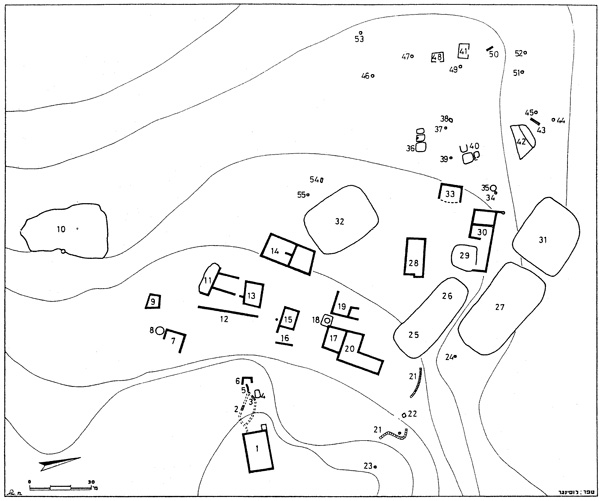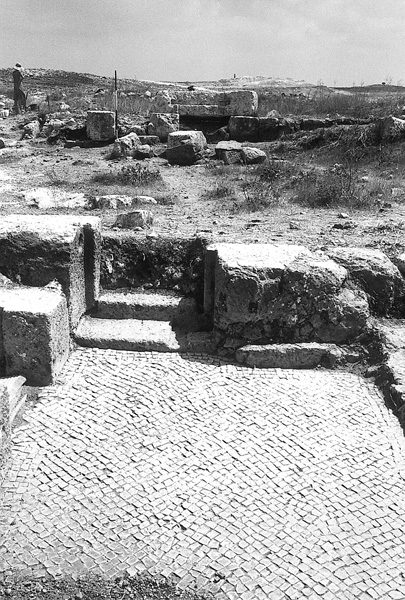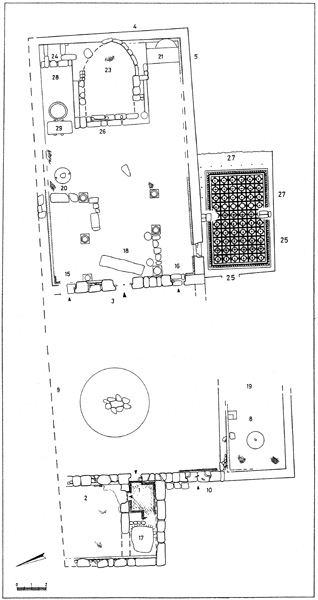Bira, Ḥorvat
THE SITE
EXCAVATIONS
Between 1980 and 1983 salvage excavations were conducted at the site on behalf of the Department of Land of Israel Studies and Archaeology at Bar-Ilan University and the Department of Antiquities and Museums, under the direction of S. Dar and Z. Safrai. In 1998 a complementary survey of ancient quarries was conducted around
EXCAVATION RESULTS
The central structure (building 1) excavated at the summit of the site consists of a basilical hall, a courtyard with a large cistern, and several broad rooms in the south and west. There is no architectural uniformity between these parts of the structure and changes and additions were made to it over time. The following phases have been identified in the structure: (1) Initially, it appears to have served as the manor house of a wealthy Jewish family (fourth–fifth centuries CE), as indicated by lamp fragments depicting a menorah found within the house. This understanding is supported by Talmudic and Tannaitic sources. (2) In the second half of the fifth or beginning of the sixth century CE, it was converted into a farmstead and included within it a church. (3) During the Early Islamic period (seventh–ninth centuries CE), it was made into an oil press; historical sources may indicate that in this phase it was again owned by Jews.

The hall of building 1 measures 16.80 by 9.50 m and includes fragments of two colored mosaic floors. The floors were removed when the building became an oil press. In the eastern part of the hall is an apse flanked by two rooms with niches, which dates to the period in which the hall was a church. Three openings were found in the western wall. Oil press installations were constructed in the hall following the destruction of the church. Abutting the hall to the south is a room (8.50 by 5.00 m) with a well-preserved colored mosaic pavement with a repeating medallion pattern, believed by the excavators to be a remnant from the initial manor house phase, however it may date to the phase of the church complex. West of the hall is the courtyard (13.20 by 9.50 m) of the building. It includes an opening to a large cistern. The western side of the courtyard is bounded by a pair of rooms, one with a small plastered pool in its floor. The uncovered courtyard and a hall to the south, with the crushing basin of an oil press, apparently functioned as part the Early Islamic period oil press.

Some 15 m northeast of building 1 was found a small installation that probably served as a mikveh when the site was inhabited by Jews. At the foot of the spur on which building 1 stands is building 15, 10.40 by 8.30 m; the manner of construction and the finds may indicate that the building was a workshop for processing hides or wool during the Byzantine and Early Islamic periods. A domestic dwelling, building 17, was also uncovered. It was in use from the Roman-Byzantine period to the Umayyad and Abbasid periods (seventh–eighth centuries CE).

The bulk of the ceramic finds dates to the Byzantine and Early Islamic periods, with pottery dating through the Mameluke period also found. However, it appears that Crusader and Mameluke period finds were from a temporary rather than a permanent settlement.
Some 50 stone quarries of various sizes in the vicinity of the site were surveyed. The nearest quarries were found at the periphery of the site, the distant ones about 1 km from the heart of the settlement. The economy of
SUMMARY
Late Roman and Byzantine period
Below the manor house would have been a small village of tenant farmers who worked the land and operated the various agricultural installations. In addition to viticulture and olives, the inhabitants of Bira had at their disposal considerable water for supplementary irrigation and animal husbandry. Building stone was probably obtained from the quarries, providing income during the periods of less agricultural activity. The transition from Jewish to Christian ownership may have occurred during the second half of the fifth or the sixth century CE. Within the manor house a spacious church was constructed. During the second half of the seventh century, following the Islamic conquest, the church was destroyed, the mosaic pavements were intentionally removed, and an oil press was constructed in place of the church. It is possible that the property reverted to Jewish ownership at this point, though this remains unclear.
SHIMON DAR, ZEEV SAFRAI
THE SITE
EXCAVATIONS
Between 1980 and 1983 salvage excavations were conducted at the site on behalf of the Department of Land of Israel Studies and Archaeology at Bar-Ilan University and the Department of Antiquities and Museums, under the direction of S. Dar and Z. Safrai. In 1998 a complementary survey of ancient quarries was conducted around
